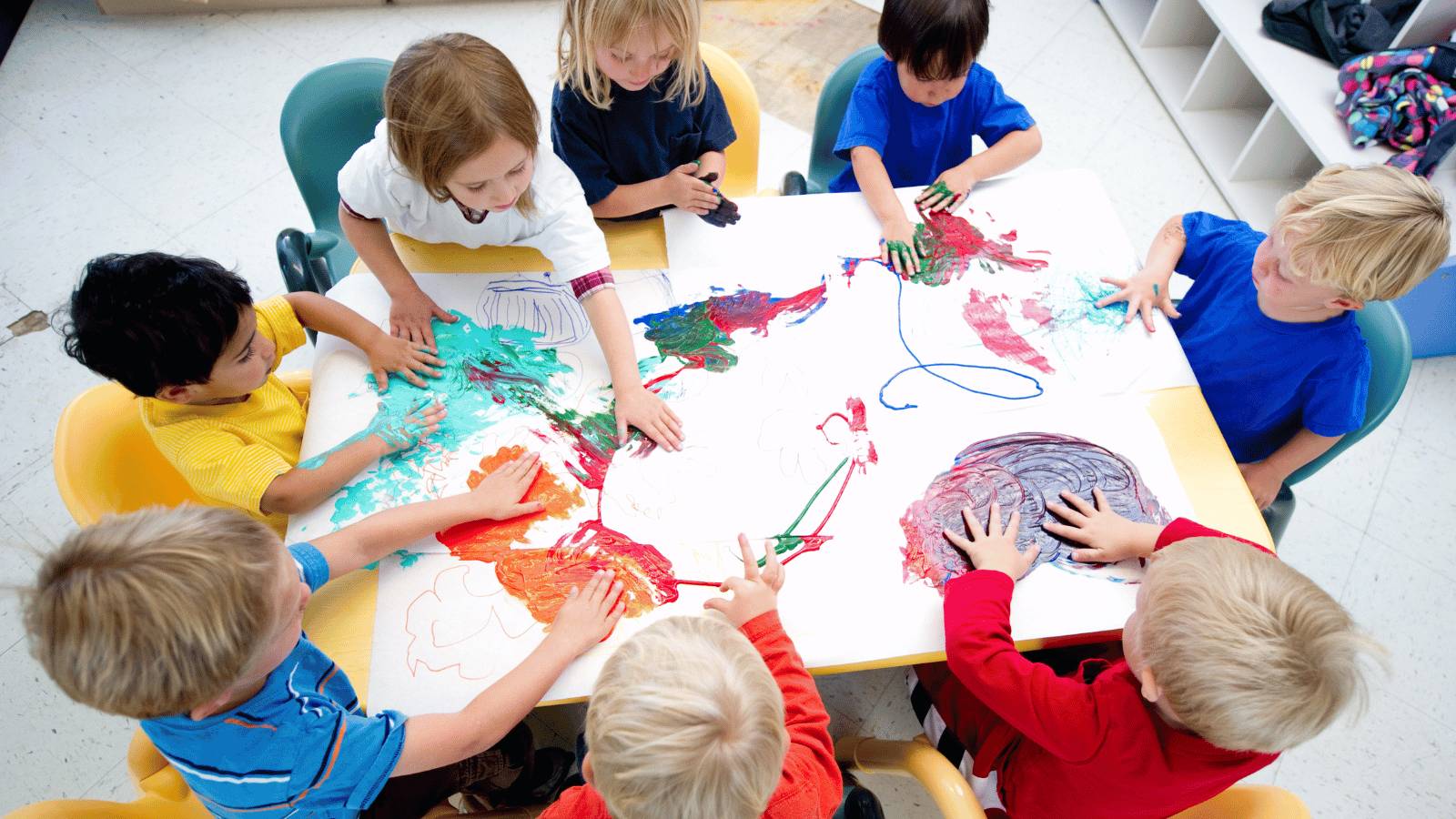
Allowing preschoolers to direct their educational experiences can make learning fun and help them gain confidence and independence. You can help your preschoolers play an active role in their education by implementing play-based, child-led preschool instruction inspired by the Waldorf method: a curriculum that uses art, movement, and hands-on activities to enrich lessons, encourage children’s creativity, and foster their love of learning.
What is Waldorf education?
The Waldorf teaching method is a type of preschool curriculum developed by Austrian scientist and philosopher Rudolf Steiner in the early 19th century. Steiner believed educators should introduce children to concepts during specific stages of development: early childhood (from birth to 7 years old), middle childhood (from 7 to 14 years old), and adolescence (from 14 to 21 years old).
Early childhood
Steiner’s philosophy states that a child under seven is “one great sense organ” that interprets the world through their senses and learns through imitation, so educators should strive to be worthy of imitation. Steiner believed children under seven should not be taught to think analytically because it threatens the development of their self-confidence and creativity.
The Waldorf curriculum for early childhood teaches children to explore the natural world through imitation and provides them with a sensory-rich, gentle, play-based learning environment.
Middle childhood
According to Steiner’s philosophy, children between the ages of eight and 14 learn best when their creativity and imagination are inspired. Steiner believed educators can promote children’s love of learning by incorporating music, fairy tales, art, and craftsmanship into the curriculum.
Steiner’s philosophy states that during this stage, children see the world as an extension of themselves, and they learn by relating their studies to humans. For example, a child in this stage of development may better understand a lesson in animal sciences if the animals are discussed as if they are humans.
The Waldorf curriculum for middle childhood focuses on nourishing children’s creative thinking, developing their social skills, and encouraging hands-on learning using movement, storytelling, drama, visual arts, and music.
Adolescence
Between 15 and 21, adolescents develop an independent intellect and the ability to think abstractly. Steiner believed children between the ages of 15 and 21 are in a transitional period between childhood and adulthood, and they learn best when given opportunities to explore their place in the world.
Waldorf high schools encourage students to embrace freedom and their roles in society. Students are mentored by specialized teachers and given increased autonomy over their education.

Waldorf education principles
The Association of Waldorf Schools of North America has adopted seven core principles for Waldorf schools. Regardless of whether your program is center-based or home-based, you can use these core principles and the practices of accredited Waldorf schools to create a child-led, play-based, developmentally appropriate curriculum for your preschoolers.
The human being as a spiritual being
The Waldorf method is built on Steiner's philosophy that a human is a threefold being of body, soul, and spirit. A Waldorf preschool curriculum includes lessons that promote children's physical, emotional, social, intellectual, artistic, and spiritual growth.
Service to society
A Waldorf education grows children's fundamental capacity to serve humanity by teaching them to strengthen their will, feel their emotions deeply, think clearly, and work with others.
Anthroposophical understanding of child development
Educators at Waldorf schools are guided by Steiner's philosophy of anthroposophy. Anthroposophy is the belief that children can grow spiritually and learn to understand the physical world by thinking clearly and developing accurate perceptions.
Educators at Waldorf schools help children learn to develop accurate perceptions and guide children through the stages of child development as they develop physically, emotionally, and intellectually and their spiritual understanding of the world evolves.
Freedom in teaching
At Waldorf schools, educators are seen as guides rather than instructors. Instead of following a rigid curriculum, the Waldorf method encourages you to work with your school's staff to review, adapt, and refine your curriculum and teaching methods based on each child's level of development and progress.
Conscious development of relationships
The Waldorf method encourages teachers to form strong relationships with their children and families and for children to form strong relationships among themselves. Educators at Waldorf schools develop strong relationships with their children's families and work with them to develop their children's individuality.
Spiritual development in support of professional growth
The Waldorf curriculum helps staff grow professionally by helping them grow spiritually through anthroposophical study. Waldorf schools offer teachers opportunities for continued education, mentoring, research, and artistic activities to further their development and provide children with the best education.
Collaboration provides the foundation of school leadership
At Waldorf schools, all educators and staff members understand social interaction as it relates to anthroposophy. This knowledge helps preschool staff share responsibility for the school's leadership and work together to develop programs.
Pros of the Waldorf teaching method
The Waldorf method has been praised as a holistic approach to education. The benefits of the Waldorf method include:
Learning is hands-on and age-appropriate
The Waldorf method uses a whole child approach that prioritizes children’s health, safety, and positive well-being while encouraging their autonomy as they explore their environment in a developmentally-appropriate manner and learn through their experiences. The Waldorf method encourages children to follow their sense of wonder and grow at their own pace to develop problem-solving skills and self-awareness.
Learning is play-based
Waldorf preschools teach children concepts through play, music, art, and social interaction. For example, before age seven, children learn phonics using eurythmy, a dance-language hybrid that teaches them the sounds of a language by having them make sounds as they dance.
The Waldorf method’s emphasis on play-based instruction allows children to become self-guided, active learners as they explore and discover ways to apply their prior knowledge to new experiences. A play-based Waldorf curriculum gives children a solid foundation for learning math skills in grade school. For example, preschoolers in Waldorf programs are taught about timing and intervals as they clap, stomp, and dance to music. Preschoolers also learn fingerplays and practice handwork, which improves their finger perception and helps them develop the motor skills that they need to count on their fingers in grade school.
Technology isn't used in the classroom
The Waldorf philosophy emphasizes learning using real-world experiences rather than virtual tools to help children actively participate in their education and form healthy relationships with the world around them.
Cons of the Waldorf method
Despite its benefits, the Waldorf method has faced criticism. Disadvantages of the Waldorf method include:
Lack of focus on academics
The Waldorf method doesn't teach children academics until the first grade. The Waldorf method also favors holistic end-of-year evaluations over grades. The end-of-year evaluations are supported by conferences and meetings with children’s families throughout the year. Using evaluations rather than grades allows children to focus on their own learning and discovery rather than competing with other children to achieve the best scores.
This lack of academic focus may cause children to struggle to measure up to their peers if they transfer from a Waldorf program to a traditional school.
Teachers teach the same children for multiple years
In Waldorf schools, children are taught by the same teacher for five to eight years, which may make it difficult for children to learn if they struggle with a particular teacher's methods and teaching style.
Incorporating the Waldorf curriculum into your preschool program
You don't need to run an accredited Waldorf school to benefit from the Waldorf method. You can easily incorporate Waldorf practices into your program's curriculum. Brightwheel's lesson plan feature includes a suite of tools that you can use to build a Waldorf-inspired preschool curriculum that meets your state's learning standards.
Follow these tips to incorporate Waldorf practices into your preschool's curriculum:
Create a consistent schedule
A predictable schedule of activities makes children feel safe and secure.
Your schedule doesn’t have to remain the same throughout the school year. You can create daily schedules that repeat every week, different schedules for each week of the year, or a different schedule for each season. No matter what type of schedule you create, be sure to abide by it. A consistent schedule will help make your children feel comfortable so they can focus on social learning and creativity.
Add natural toys and furniture to your classroom
Waldorf schools believe children's toys should be simple, natural, and open-ended. Undetailed toys made of natural materials, such as cloth dolls that don't have faces, stimulate children's imaginations, encourage creative play, and teach children about representation, diversity, identity, and self-image.

Have children help you clean the classroom
At Waldorf schools, teachers and children work together to clean the classroom. Give your children developmentally appropriate cleaning tasks to help them develop a strong sense of community and social responsibility. For example, after meals, you can have children help you pick up trash from tables or wipe tables with a paper towel, depending on their capabilities.
Explore nature with your children
Exploring nature gives children opportunities to think freely and interact with their environment in meaningful ways. You can have lessons outside in nice weather or start a classroom garden. Incorporating outdoor exploration and nature into your preschool program teaches children to respect nature and helps them develop an interest in the natural world.
Final thoughts
The Waldorf method combines nature, community, the arts, and knowledge of child development to give children opportunities to learn through exploration. You can use the principles of the Waldorf method in your classroom to encourage self-guided learning, help your preschoolers develop an appreciation for nature, and teach them to take pride in being a member of their classroom community and the natural world.

